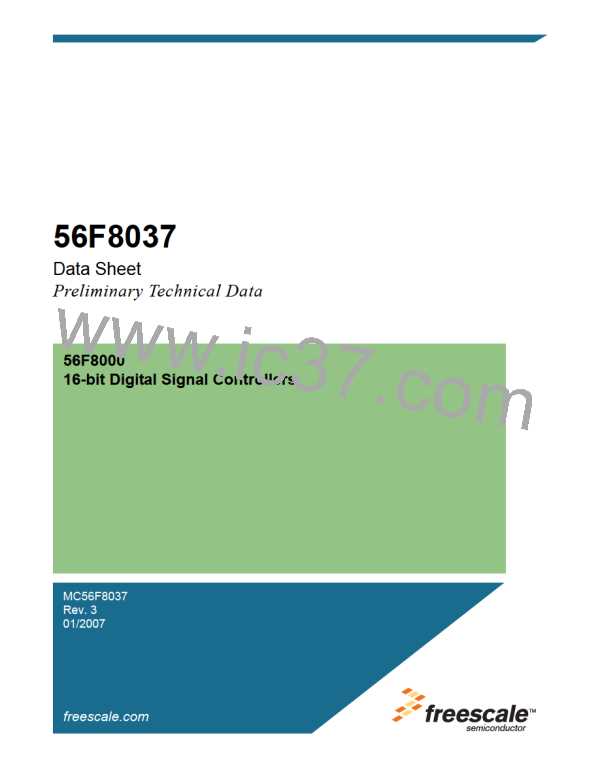56F8037 Signal Pins
Table 2-3 56F8037 Signal and Package Information for the 64-Pin LQFP (Continued)
Signal
Name
LQFP
Pin No.
StateDuring
Reset
Type
Signal Description
GPIOB6
1
Input/
Output
Input,
internal
pull-up
enabled
Port B GPIO — This GPIO pin can be individually programmed as
an input or output pin.
(RXD0)
Input
Receive Data 0 — QSCI0 receive data input.
(SDA21
)
Serial Data — This pin serves as the I2C serial data line.
Input/
Output
Input
(CLKIN)
External Clock Input — This pin serves as an optional external
clock input.
After reset, the default state is GPIOB6. The peripheral functionality
is controlled via the SIM (See Section 6.3.16) and the CLKMODE bit
of the OCCS Oscillator Control Register.
21The SDA signal is also brought out on the GPIOB1 and GPIOB9 pins.
GPIOB7
3
Input/
Output
Input,
internal
pull-up
enabled
Port B GPIO — This GPIO pin can be individually programmed as
an input or output pin.
(TXD0)
Input/
Transmit Data 0 — QSCI0 transmit data output or transmit / receive
Output
in single wire operation.
(SCL22
)
Serial Clock — This pin serves as the I2C serial clock.
Input/
Output
After reset, the default state is GPIOB7. The peripheral functionality
is controlled via the SIM. See Section 6.3.16.
22The SCL signal is also brought out on the GPIOB0 and GPIOB8 pins.
GPIOB8
54
Input/
Output
Input,
internal
pull-up
enabled
Port B GPIO — This GPIO pin can be individually programmed as
an input or output pin.
(SCL23
)
Serial Clock 1 — This pin serves as the I2C serial clock.
CAN Transmit Data — This is the SCAN interface output.
Input/
Output
Open Drain
Output
(CANTX24
)
After reset, the default state is GPIOB8. The peripheral functionality
is controlled via the SIM. See Section 6.3.16.
23The SCL signal is also brought out on the GPIOB0 and GPIOB7 pins.
24The CANTX signal is also brought out on the GPIOB12 pin.
Return to Table 2-2
56F8037 Data Sheet, Rev. 3
Freescale Semiconductor
Preliminary
31

 FREESCALE [ Freescale ]
FREESCALE [ Freescale ]